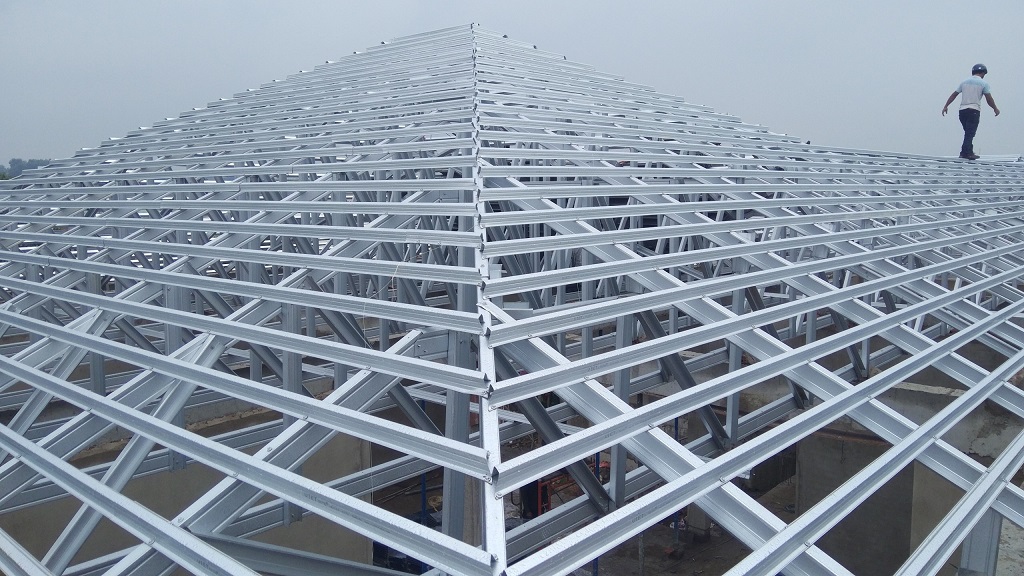Mái ngói vốn là phần che chở cho ngôi nhà, là một bộ phận không thể thiếu, vậy quy trình lợp mái ngói như thế nào? Khi lợp mái ngói ta cần phải lưu ý những gì? Với những kinh nghiệm của mình, MOIVAONHATOI xin giới thiệu cho bạn quy trình lợp mái ngói chuẩn nhất hiện nay (bản cập nhật năm 2020).
KẾT CẤU MÁI NGÓI
Trước khi bước vào quy trình lợp mái ngói, ta phải nắm rõ kết cấu mái ngói để đảm bảo khi lợp ngói có đầy đủ các bộ phận cần thiết. Cấu tạo của mái ngói bao gồm:
- Hoành là: các dầm chính đỡ mái mặt nằm ngang theo chiều dài nhà, vuông góc với khung nhà
- Rui là: các dầm phụ trung gian, đặt dọc theo chiều dốc mái (trực giao với hoành), gối lên hệ thống hoành.
- Mè là: các dầm phụ nhỏ, đặt trực giao với dui, song song với hoành, gối lên hệ dui. khoảng cách giữa các mè là nhỏ nhất, vừa đủ để lợp ngói. Việc sử dụng hệ kết cấu hoành – dui – mè, nhằm phân nhỏ nhịp của kết cấu đỡ mái thành hệ lưới vừa đủ để lát lớp gạch màm và lợp ngói bên trên.
CÁC LOẠI MÁI NGÓI HAY ĐƯỢC SỬ DỤNG HIỆN NAY
Một bước nữa trước khi bước vào quy trình lợp mái ngói là bạn phải nắm rõ loại ngói mình muốn sử dụng cho căn nhà của mình. Hiện nay trên thị trường có hai loại ngói phổ biến là: ngói đất nung, và ngói màu
NGÓI ĐẤT NUNG
Ngói đất nung hay còn gọi là ngói nung, ngói đất sét, ngói đất sét nung,… Đây là loại vật liệu truyền thống được sử dụng rất phổ biến trong nhiều mẫu nhà ở nông thôn.
NGÓI MÀU
Ngói màu được sử dụng thường xuyên hiện nay. Giống như tên gọi, loại ngói này có rất nhiều màu sắc đa dạng có thể lựa chọn.
QUY TRÌNH LỢP MÁI NGÓI
Quy trình lợp mái ngói nói chung bao gồm 6 bước chính sau:
BƯỚC 1: CHÚ Ý ĐẾN ĐỘ DỐC CỦA MÁI
Chú ý đến độ dóc của mái là một bước quan trọng trong quy trình lợp mái ngói. Theo đó, bước đầu tiên này bao gồm những thông số kĩ thuật như sau:
- Độ dốc mái 30 độ, điều đó có ý nghĩa là cứ 1m đo theo chiều ngang, kèo phải nâng lên 0.57m
- Độ dốc 30 độ chỉ cho phép chiều xuôi mái ngói tối đa là 10m.
- Độ dốc 45 độ có chiều xuôi mái ngói từ 10m đến 15m.
- Độ dốc trên 45 đến 60 độ có chiều xuôi mái ngói không giới hạn.
- Đo chiều dài “L” từ hàng đòn tay đầu tiên đến hàng đòn tay ở nóc, lấy chiều dài “L” chia cho 280 đến 300 sẽ tính được số đòn tay. ( R<= 320).
- Độ cao của đỉnh đòn tay, cuối cùng phải cao hơn đỉnh đòn tay trước nó là 25.
- Khoảng cách giữa 2 li tô ( tâm nối tâm) đồng nhất, nằm trong khoảng từ 340 đến 360mm. Khoảng cách này phải đồng nhất trong toàn bộ khung kèo mái ngói, đảm bảo các li tô phải được thiết kế và lắp đặt song song với nhau. Chia li tô từ trên đỉnh mái chia xuống.
- Lưu ý: Chiều dài “L” phụ thuộc vào độ dốc và chiều dài mái. Hai đòn tay trên nóc giữ khoảng cách 4- 6cm. Đặt hàng đòn tay đầu tiên bằng cách lấy khoảng cách từ tim của đòn tay thức hai L từ 28-32cm ( tùy thuộc chiều dài và độ dốc mà ta bố trí).
- Lợp đầy đủ một hàng dưới làm chuẩn, sau đó tiếp tục lợp lên. Lợp ngói theo cách thức phân thức phân khúc từ dưới lên. Cứ 10 viên gói đặt 1 dây dọi từ nóc đến phía dưới đẩ đảm bảo chúng thẳng hàng. Lợp từ phải qua trái, viên ngói đầu tiên phải đặt ở góc bên phải cách mép ngồi của kèo là 3cm. Đóng đinh cho mỗi viên ngói ở hàng đầu vào đòn tay bằng đinh 5cm cho đòn tay gỗ hoặc ốc vít 5cm cho đòn tay bằng kim loại .
- Lợp ngói lần lượt từ phải sang trái, từ dưới lên trên.
BƯỚC 2: CHÚ Ý VỀ KHOẢNG CÁCH LỢP NGÓI
Trong quy trình lợp mái ngói, khoảng cách lợp ngói là một điều rất quan trọng mà bạn cần phải lưu ý:
- Đối với các loại ngói sóng hiện nay, không nên lợp các viên ngói quá khít theo mạch sẵn có bởi khi lợp mái, nhiệt độ mái tăng cao, sẽ gây ra hiện tượng giãn nở. Khi giãn nở vì nhiệt, các viên ngói sẽ được giãn sang 2 bên trái và phải. Đồng thời, vị trí giữa các viên ngói sẽ bị xô lệch ( bị kênh) lên so với vị trí lợp ban đầu sẽ dễ gây ra hiện tượng vỡ ngói. Vì vậy, lưu ý đầu tiên đó là phải lợp ngói với khoảng cách vừa đủ.
- Khoảng cách vừa đủ đối với các loại ngói sóng lớn, hoặc sóng nhỏ hiện nay dao động trong khoảng từ 0.7 đến 1.2mm. Thao tác cần thiết của người thợ khi tiến hành lợp ngói đó là cần phải “ Lắc nhẹ” khi đặt từng viên ngói lên mè. Khi lắc nhẹ trước khi đặt, các viên ngói sẽ được đặt vào với khoảng cách đủ khít nhưng không quá chật, vẫn có khoảng cách vừa đủ để ngói giãn nở nhiệt. Bạn sẽ thắc mắc về việc lắc như thế nào được coi là đủ đối với ngói lợp, điều này sẽ còn phụ thuộc khá nhiều vào kinh nghiệm và độ khéo của người thợ lợp ngói.
BƯỚC 3: CHÚ Ý DI CHUYỂN TRÊN MÁI NGÓI TRÁNH BỂ, VỠ
Khi thực hiện các bước trong quy trình lợp mái ngói, những người thợ phải thường xuyên di chuyển trên mái nên tình trạng bể hay vỡ mái ngói có thể xảy ra bất cứ lúc ào. Vì thế chúng tôi đã để riêng bước 3 để hướng dẫn bạn tránh khỏi sơ xuất này:
- Khi bước trên mái ngói, nhiều người thường không để ý đến vị trí bước, điều này vừa gây nguy hiểm trong quá trình thi công , đồng thời dễ gây ra hiện tượng vỡ ngói. Khi bước trên mái ngói cần phải bước lên vị trí mũi ngói, tránh việc bước lên vào các gờ chống mí nơi 2 viên ngói tiếp giáp nhau.
BƯỚC 4: CÁCH LỢP NGÓI RÌA
- Trong quy trình lợp mái ngói, viên ngói cuối rìa được lợp đầu tiên, khi gắn viên ngói cuối rìa, cần chú ý sao cho nó che phủ vừa hết chiều dài viên ngói chính ở hàng thứ nhất. Nên khoan thủng các lỗ đinh trên thân ngói cuối rìa trước khi bắt ốc vít. Tất cả các viên ngói rìa cần phải được bắt vít cố định vào mè qua vị trí lỗ đinh trên thân ngói. Khi tiến hành lợp ngói, bạn phải đảm bảo rằng, các viên ngói rìa phải bao phủ toàn bộ rìa mái, đầu lớn của viên ngói rìa bên trên nằm chồng lên đầu nhỏ của viên ngói rìa bên dưới.
- Tại vị trí giao nhau của rìa ngói và nóc ngói, sử dụng ngói cuối nóc sao cho 2 viên ngói rìa nằm càng sát nhau càng tốt. Đặc biệt chú ý trong cách thức lợp mái ngói nhà ở đối với ngói rìa, không nên sử dụng vữa để gắn ngói rìa bởi vữa sẽ dễ bị khô khi đông cứng. Khi vệ sinh mái ngói sau khi hoàn thiện cũng khó khăn, tốn thêm nhân công.
BƯỚC 5: CÁCH LỢP NGÓI CUỐI MÁI, NGÓI NÓC, CUỐI NÓC
- Lợp viên ngói cuối mái hoặc cuối nóc trước khi bước đến quy trình lợp ngói nóc. Ngói nóc sẽ được lợp tiếp theo. Ngói nóc, cuối nóc và cuối mái được liên kết bằng vữa dẻo thô ở vị trí chân viền ngói. Khi vữa đã đủ độ cứng thì lấy bay thép cắt bỏ vữa thừa và làm nhẵn.
BƯỚC 6: VỆ SINH HOÀN THIỆN MÁI NGÓI
- Và bước cuối cùng không thể thiếu trong quy trình lợp mái ngói là vệ sinh sạch sẽ phần vữa dính trên mặt ngói. Ngoài ra, bạn có thể dùng sơn bảo vệ ngói và tăng độ bóng cho mái ngói.
Trên đây là những bước cơ bản và lưu ý trong quy trình lợp mais ngói. Hy vọng bạn nắm chắc những kiến thức này để giám sát thợ khi thi công lợp ngói.



